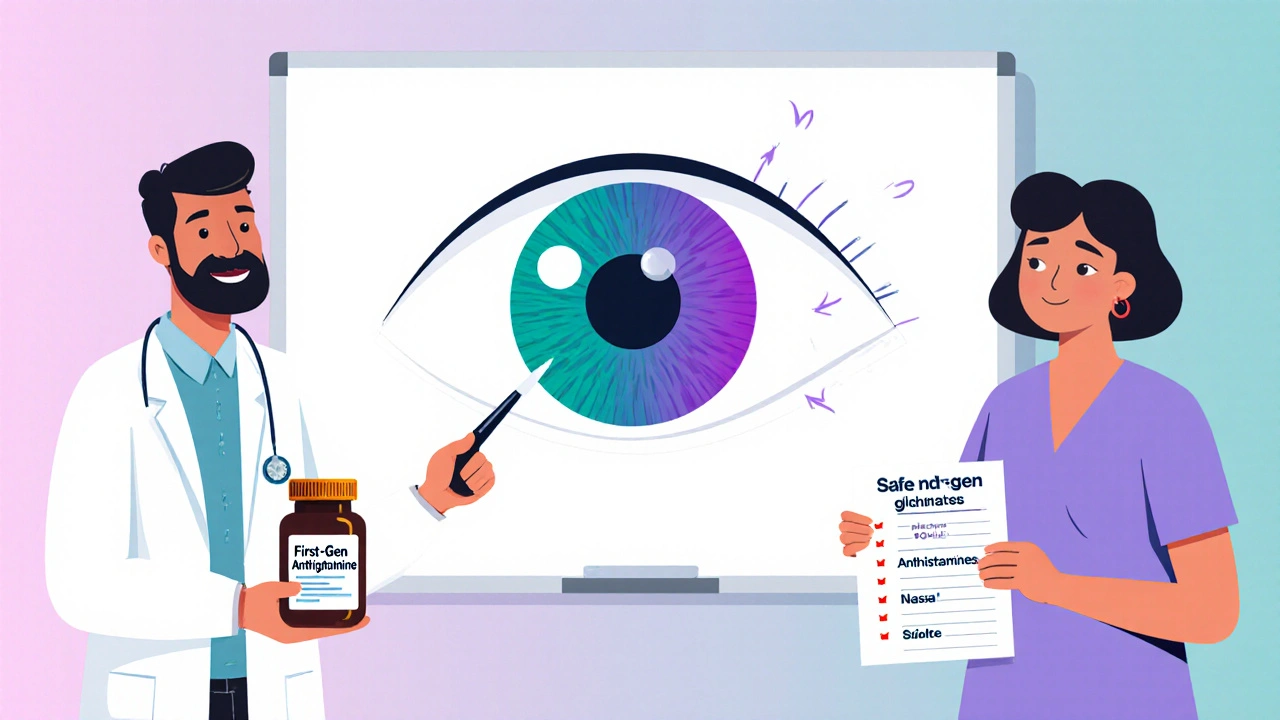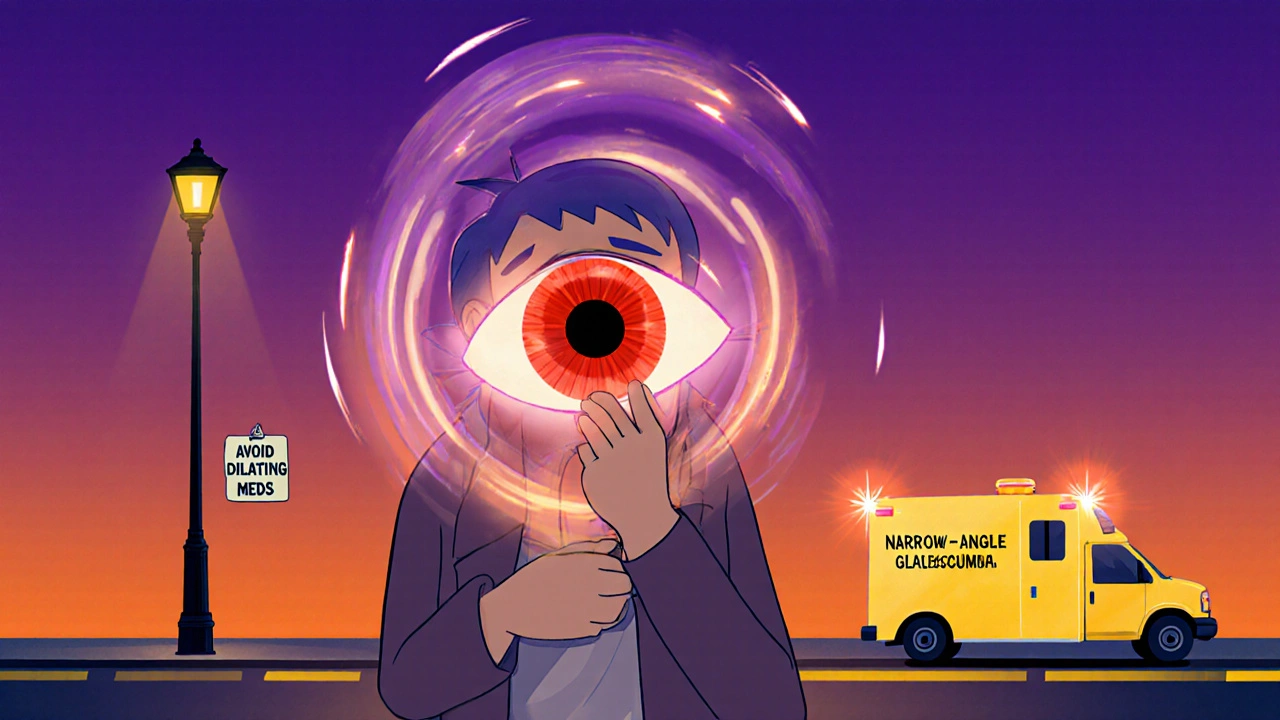25 Oct 2025
- 15 Comments
Glaucoma Medication Risk Checker
Medication Safety Assessment
This tool helps determine if common allergy medications are safe for your glaucoma type. Important: Always consult your ophthalmologist before taking any new medication.
Risk Assessment Results
When it comes to eye health, Antihistamines are drugs that block histamine receptors to relieve allergy symptoms like sneezing, itching and runny nose. For most people they’re harmless, but if you have Glaucoma, especially the narrow‑angle form, they can turn a simple cold into an eye‑emergency.
Why antihistamines can raise eye pressure
First‑generation antihistamines such as diphenhydramine (Benadryl) and chlorpheniramine have strong anticholinergic effects. Those effects cause the pupil to dilate (mydriasis). In eyes with already‑tight drainage angles, the dilated pupil pushes the iris forward, narrowing the iridocorneal angle even more. The result is a blockage of aqueous humor outflow and a rapid spike in intra‑ocular pressure (IOP). When IOP climbs quickly, the condition is called acute angle‑closure glaucoma (AACG) and can lead to permanent vision loss if not treated within hours.
Glaucoma types and medication safety
Glaucoma isn’t a single disease. The two main categories are:
- Primary open‑angle glaucoma (POAG) - accounts for ~70% of cases. The drainage angle is open, so most antihistamines and decongestants are low risk, except for prolonged steroid use.
- Narrow‑angle (or primary angle‑closure) glaucoma - about 10‑15% of patients. Their drainage angles are naturally tight, making them vulnerable to anything that dilates the pupil.
Because the risk hinges on anatomy, the same medication can be safe for one patient and dangerous for another.
Which allergy meds are problem‑free and which are red flags?
The table below breaks down the most common allergy‑related products and how they interact with each glaucoma type.
| Medication class | Typical active ingredient(s) | Effect on pupil | Risk for POAG | Risk for narrow‑angle glaucoma |
|---|---|---|---|---|
| First‑generation antihistamines | Diphenhydramine, Chlorpheniramine | Strong dilation (anticholinergic) | Low | High - can trigger AACG |
| Second‑generation antihistamines | Loratadine, Cetirizine, Fexofenadine | Minimal | Low | Low‑moderate - still consult ophthalmologist |
| Decongestants (oral) | Pseudoephedrine, Phenylephrine | Vasoconstriction can cause secondary dilation | Low | Moderate - may raise IOP |
| Topical or nasal steroids | Fluticasone, Betamethasone | None directly, but can increase IOP over days | Low‑moderate - limit to <10 days | Low‑moderate - monitor pressure |
| Antiemetics (anticholinergic) | Meclizine, Promethazine | Pupil dilation | Low | High - avoid in narrow angles |

Safer ways to manage allergies if you have glaucoma
Here’s a quick checklist you can follow before reaching for the next bottle:
- Know your glaucoma type. A simple gonioscopy performed by an eye specialist will tell you whether your angles are open or narrow.
- Ask your ophthalmologist. Even second‑generation antihistamines may need a green light if you’ve had recent laser iridotomy or cataract surgery.
- Prefer non‑dilating options. Nasal saline rinses, eye‑safe moisturizers, or oral antihistamines with minimal anticholinergic activity are usually okay.
- Limit steroid exposure. Use steroid nasal sprays for no longer than ten days, and have your eye pressure checked afterward.
- Carry a medical alert. A card stating “Narrow‑angle glaucoma - avoid antihistamines that cause pupil dilation” can save minutes in an emergency.
What to do if you experience sudden eye pain
Acute angle‑closure glaucoma often presents with:
- Severe, throbbing eye pain
- Blurred vision or halos around lights
- Nausea or vomiting
- Red, hot eye
If any of these appear after taking an allergy medication, treat it as an emergency:
- Stop the medication immediately.
- Seek urgent ophthalmic care - most hospitals have an eye‑emergency service.
- If you have a prescribed miotic (e.g., pilocarpine) for glaucoma, use it only under professional advice.
Timely treatment (often laser peripheral iridotomy) can restore normal pressure and prevent permanent damage.

Public health impact and future directions
In the UK, hay fever affects roughly one in five people, while about three million residents live with glaucoma. That means up to 300,000‑450,000 Britons could be at risk of medication‑induced AACG every year. Yet most OTC labels don’t warn about glaucoma, leaving patients unaware.
Encouraging signs include:
- Routine gonioscopy becoming standard for anyone over 40 (American Academy of Ophthalmology, 2021).
- Clinical trials exploring modified‑release loratadine with less ocular penetration (NCT04876321, 2023).
- Advocacy groups like Glaucoma UK pushing the MHRA for clearer labeling.
Research also hints that common statins might protect against open‑angle glaucoma progression, offering a potential dual‑benefit for patients already on cholesterol medication.
Take‑away summary
Antihistamines are a double‑edged sword for glaucoma patients. If you have primary open‑angle glaucoma, most allergy meds are safe, but steroids need monitoring. If you have narrow‑angle glaucoma, steer clear of first‑generation antihistamines, anticholinergic anti‑nausea drugs, and be cautious with decongestants. Always confirm your specific glaucoma type with an eye specialist before self‑medicating.
Can I use loratadine if I have narrow‑angle glaucoma?
Loratadine is a second‑generation antihistamine with minimal anticholinergic activity, so many ophthalmologists consider it lower risk. However, you should still ask your eye doctor because individual anatomy varies.
Do over‑the‑counter nasal sprays affect glaucoma?
Nasal steroids such as fluticasone can raise IOP if used for more than ten days. Short‑term use (<7 days) is generally safe, but schedule a pressure check after the course.
What symptoms signal an acute angle‑closure attack?
Sudden severe eye pain, blurry vision with halos, a red eye, and nausea are classic signs. Treat as an emergency and stop any antihistamine you just took.
Are there natural antihistamines safe for glaucoma?
Herbal remedies like quercetin or butterbur have mild antihistamine effects, but clinical evidence is limited. Always discuss with your ophthalmologist before substituting.
How often should I have my eye pressure checked if I use steroids?
After a course of nasal or oral steroids longer than five days, schedule a pressure check within two weeks, then follow your doctor’s routine monitoring plan.


Edward Brown
October 25, 2025They don't tell you that the very meds that soothe a sneeze could be a covert tool to sabotage your eyes it's all part of the big pharma playbook you trust the label but the hidden anticholinergic side effects are a gateway for something bigger
Justin Scherer
October 25, 2025For folks with open‑angle glaucoma, most second‑generation antihistamines like loratadine are generally safe, but it's still worth checking with your ophthalmologist before starting any new allergy medication.
Cheyanne Moxley
October 26, 2025Honestly anyone who dismisses the danger of first‑gen antihistamines for narrow‑angle patients is just reckless; you could wake up with irreversible vision loss and no one will care.
Kevin Stratton
October 26, 2025Think of the eye as a delicate balance ⚖️-when the pupil dilates in a cramped angle, pressure spikes like a ticking bomb, and the only antidote is awareness and proper medical guidance.
Megan Dicochea
October 26, 2025The key takeaway is simple keep an eye on the meds you take especially if you know your angle is tight you don't need to panic but you do need to stay informed and talk to your doc before popping that Benadryl
Jennie Smith
October 26, 2025💡Quick tip: if you need an allergy remedy and have narrow‑angle glaucoma, reach for a non‑sedating antihistamine and avoid anything that could cause pupil dilation.
Anurag Ranjan
October 26, 2025In practice, I always ask patients with angle‑closure history to review any otc antihistamine labels for anticholinergic warnings.
James Doyle
October 26, 2025The relationship between antihistamines and intra‑ocular pressure is a classic illustration of pharmacodynamics intersecting with ocular anatomy, and anyone who thinks it’s irrelevant is simply ignoring basic physiology. First‑generation antihistamines possess strong anticholinergic activity, which manifests as mydriasis-a pharmacologic dilation of the pupil that may seem benign in the general population. However, in eyes where the iridocorneal angle is already compromised, that extra dilation can literally push the peripheral iris into the trabecular meshwork, sealing off the primary outflow pathway for aqueous humor. The resultant bottleneck effect precipitates a rapid elevation of intra‑ocular pressure, often crossing the 30 mm Hg threshold within hours. Clinically this scenario is defined as acute angle‑closure glaucoma, a true ophthalmic emergency that can cause irreversible optic nerve damage if not promptly addressed. The cascade of events-anticholinergic receptor blockade, pupil dilation, iris bombe, peripheral anterior synechiae formation, and pressure spike-underscores why seemingly innocuous OTC meds can become lethal tools in the right (or wrong) anatomical context. Moreover, not all antihistamines are created equal; second‑generation agents like cetirizine and fexofenadine exhibit minimal anticholinergic properties, thereby posing a substantially lower risk profile for angle‑closure patients. Even so, individual variability in drug metabolism and receptor sensitivity means that a cautious approach is warranted. Decongestants, while primarily vasoconstrictors, can indirectly exacerbate pupil dilation via sympathetic stimulation, adding another layer of risk for narrow‑angle individuals. Topical or intranasal steroids, on the other hand, may induce steroid‑responsive IOP elevation over days to weeks, compounding the problem if used indiscriminately. The bottom line for clinicians is to perform a thorough medication review and educate patients about the signs of an acute attack: sudden eye pain, blurred vision, halos around lights, and nausea. Patients should be advised to seek immediate care if these symptoms arise after taking any antihistamine, especially the first‑generation types. From a public health perspective, pharmacy labeling could be improved to flag high‑risk drugs for those with known narrow angles. Finally, interdisciplinary communication between ophthalmologists, primary care physicians, and pharmacists is essential to prevent iatrogenic vision loss. In short, the interplay of drug chemistry and eye structure is not just academic-it has real, sight‑saving implications.
Melody Barton
October 26, 2025Don't let anyone tell you a cheap Benadryl is harmless if you have narrow‑angle glaucoma-stop the careless advice and get a safe alternative now.
Greg Galivan
October 26, 2025Seriously you cant just ignore the risk, if you take a first gen antihistamine and get a sudden eye pain you are looking at possible permanent damage.
ALBERT HENDERSHOT JR.
October 26, 2025It is imperative that patients with a diagnosis of primary angle‑closure be counseled on the pharmacologic profiles of antihistamines, and that clinicians document this discussion in the medical record 😊.
Kala Rani
October 26, 2025Maybe the whole warning is overblown; after all people have taken these meds for decades without catastrophe.
Donal Hinely
October 26, 2025Overblown? That's a joke-look at the cases where a simple cold remedy turned into a vision‑threatening emergency, it's not a myth.
christine badilla
October 26, 2025Picture this: you pop a pill for a sneeze, and minutes later your world goes dark, the colors fade, and you realize a harmless drug just stole your sight-pure nightmare material.
Octavia Clahar
October 27, 2025Always double‑check with your eye doctor before reaching for OTC allergy meds.